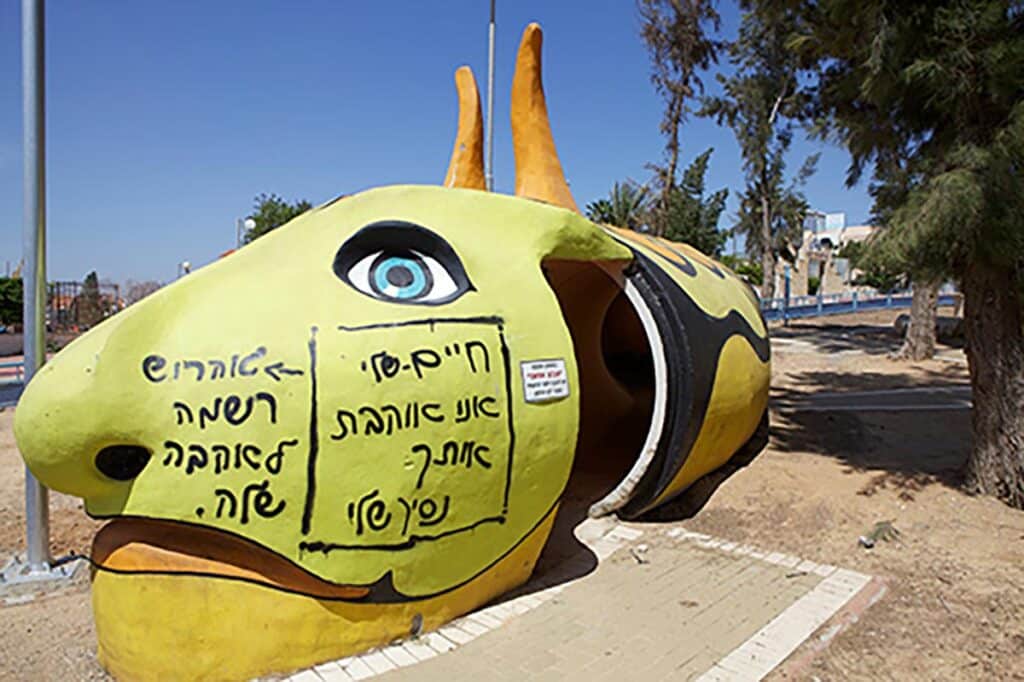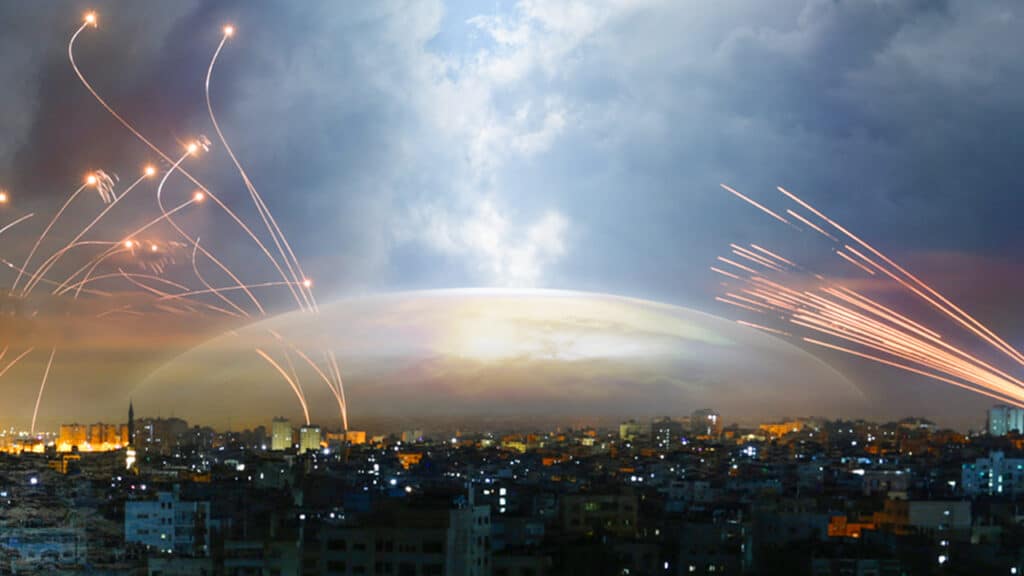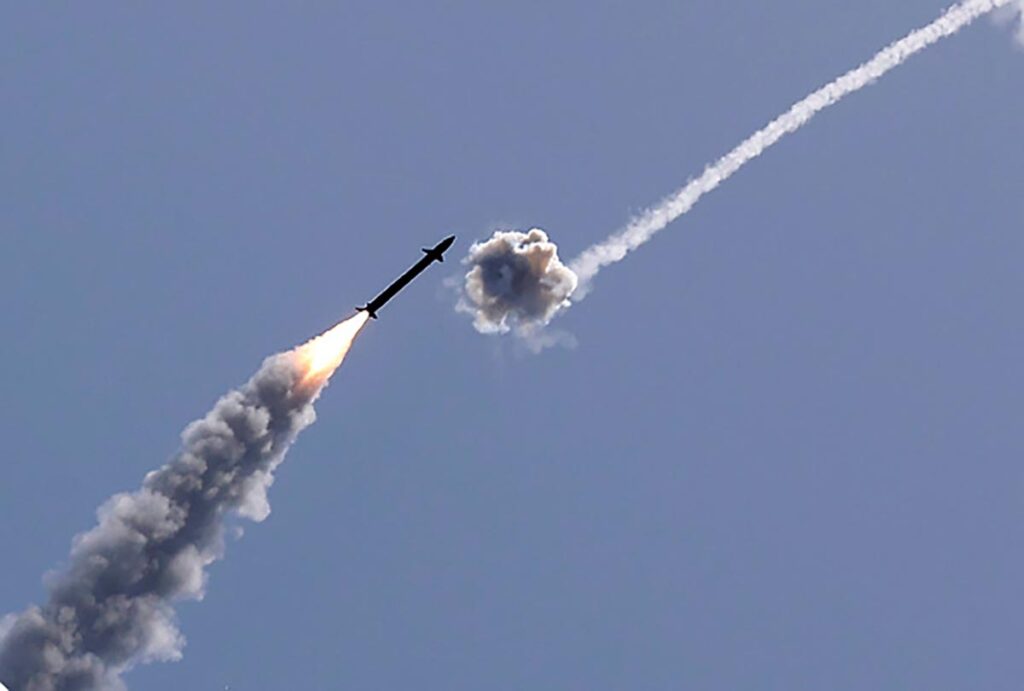Imagine this: you’re in Sderot, Israel, located just a mile away from the Gaza Strip, during the early 2000s. It’s a seemingly tranquil town, yet life here is far from calm.
One moment, children are playing joyfully in the park; the next, they are running — not for a game of tag, but for their lives. They have about 15 seconds to find shelter.
This is not a scene from a gripping thriller, but the grim reality that characterized life in Sderot, infusing daily life with fear and uncertainty.
In response to this precarious situation, homes, schools, and even playgrounds were equipped with bomb shelters — not just in Sderot, but in numerous other towns across southern Israel as well.

According to the Israel Defense Forces, between 2000 and 2008, over 4,000 rockets landed in southern Israel from the Gaza Strip.
The impact of these attacks was devastating, claiming many lives and causing countless injuries. This climate of fear and the specter of unpredictability had draped itself over everyday life.
Fast forward to today, and the story is different. The threat of rocket attacks persists, but now, there’s an underlying sense of resilience and security.
The catalyst for this transformation? A game-changing piece of technology known as the Iron Dome, and in 2023, its more advanced counterpart, David’s Sling.

These technological marvels have reshaped the dynamics of defense and survival in a region continually marked by conflict. While they’re not a replacement for peace, they’ve significantly shifted the odds in the face of a persistent threat.
So, this week, we wanted to dive deeper into the story of how the Iron Dome and David’s Sling came to be and the impact these technologies have had on millions of Israelis.
Against all odds: The story of the Iron Dome
The tale of these groundbreaking systems is one of ingenuity and necessity. It’s a story that begins with a vision by Amir Peretz, an Israeli politician and former Defense Minister, who was born and raised in one of the towns most frequently targeted by rocket attacks — Sderot.
In 2005, as Israel withdrew from the Gaza Strip and rocket attacks multiplied, Peretz, the newly appointed Defense Minister, envisioned a defensive system that could intercept rockets mid-air.
Many Israelis, including fellow defense officials, dismissed the project as technologically unfeasible — akin to hitting a bullet with a bullet.
In addition, some senior military officials took issue with the defensive nature of the technology.
“We call our army, the Israel Defense Forces,” Peretz told Tablet Magazine. “But our military strategy has always been built on offensive capabilities. The military was concerned that defensive strategies would make our enemies think that we are weak. The army has always thought that the only response to force is more force.”
“As minister of defense, I had to convince the army that defensive measures against terror were a sound strategy,” he added.
As the barrage of rocket attacks continued, Peretz held steadfastly to the possibility of a defense system capable of shielding Israelis from harm. This relentless vision led to the inception of the Iron Dome project.

In 2008, Rafael Advanced Defense Systems, an Israeli defense technology company, introduced the first prototype of the Iron Dome. As Israel showcased the Iron Dome project globally, skepticism was rampant. A delegation of U.S. missile experts only gave it a 15% chance of success.
However, the tide started to turn when Barack Obama visited Israel in July 2008, a few months before his election as President. In Sderot, he met with people living under the constant threat of rocket attacks and expressed solidarity with them.
“I’m here to say, as an American and as a friend of Israel, that we stand with the people of Sderot and with all the people of Israel,” then-presidential candidate Obama said.
“The Qassam rockets fired by Hamas deliberately and indiscriminately target civilians. This terror is intolerable. Israelis should not have to live endangered in their homes and schools.”
By 2010, Israel had conducted several successful tests of the Iron Dome. The American delegation returned to Israel to observe the progress and was left astounded.
They went from expressing a mere 15% confidence in the project to declaring a 100% probability of success. This vote of confidence was instrumental in President Obama approving $205 million in funding for the Iron Dome in 2010.
This pivotal moment hastened the development and deployment of the system. In 2011, the Iron Dome was declared operational, and it quickly proved its worth, intercepting rockets with an impressive success rate of 75% — a figure that quickly silenced skeptics at home and abroad.
The Iron Dome brought a profound change in the dynamics of defense and survival in towns like Sderot and across Israel. In May 2023, during the latest round of fighting between Islamic Jihad and Israel, the Iron Dome boasted a 96% success rate in intercepting rockets fired from Gaza.
New defensive technologies: From the Iron Dome to David’s Sling
But the story didn’t end there. While the Iron Dome excels at intercepting short-range rockets, there remained a gap in Israel’s defense for medium- and long-range rockets.
Enter David’s Sling — the Iron Dome’s big brother — which picks up where the Iron Dome’s reach ends.
Specifically, while the Iron Dome intercepts rockets fired from 2.5 to 40 miles (4 to 70 kilometers) away, David’s Sling handles those fired from a distance of 25 to 190 miles (40 to 300 kilometers).
In May 2023, David’s Sling made its first real-world interception, demonstrating its capability to destroy medium to long-range rockets and missiles.
The IDF continues to develop new defensive technology, including the Arrow system for long-range missile threats. It also recently completed tests of its naval version of the Iron Dome, known as the C-Dome. Recently, the IDF released this video of the test:
@treyyingst Israel releases new video as they test the “Naval Iron Dome” #Israel #Palestine #News
♬ original sound – Trey Yingst
Now, envision these technologies working in tandem – the Iron Dome, David’s Sling, and the Arrow system.
They serve as a three-layer shield against all kinds of aerial threats, illustrating Israel’s unwavering commitment to securing its people. At the same time, the necessity for such measures in the first place underscores the significant threats facing Israel.
Diverse perspectives on the Iron Dome
Despite these efforts, there are dissenting opinions. In 2021, a faction of progressive Democrats in the U.S. Congress stalled a bill to replenish funds for the Iron Dome.
“I will not support an effort to enable war crimes, human rights abuses, and violence. We cannot focus solely on Israel’s safety when Palestinians are living under a violent apartheid system,” Congresswoman Rashida Tlaib said on the House floor.
It’s crucial to remember, though, that the Iron Dome is designed for defense — to shield civilians from fatal rocket attacks — not to harm Palestinians. And in many ways, it benefits Palestinians as well, which we’ll delve into later.
Then-Congressman Ted Deutch, however, firmly rejected Tlaib’s perspective:
“I cannot allow one of my colleagues to stand on the floor of the House of Representatives and label the Jewish democratic State of Israel an apartheid state. I reject it… To advocate for the dismantling of the one Jewish state in the world when there’s no place on the map for one Jewish state, that’s antisemitism.”
This controversy temporarily blocked Iron Dome’s funding, shedding light on a growing U.S. debate about financial backing for Israel’s military.
Even within Israel, perspectives on these air defense systems vary. Some argue that these systems act as a band-aid instead of addressing the underlying problem.
Yoav Fromer, a professor at Tel Aviv University, argued that the system removes some of the urgency for Israel’s leaders to actively negotiate a peace agreement with Palestinians, writing in a Washington Post op-ed:
“Technology can mislead us by providing a false sense of security. But it cannot – and must not – become a substitute for effective diplomacy…Since the Iron Dome has transformed a grim reality into a somewhat bearable ordeal, Israelis have lost the sense of urgency and outrage that might have pushed their government to make painful, yet necessary concessions in exchange for peace.”
Other Israelis express unease over the dependence on the U.S. for financing the Iron Dome, underscoring that it causes a feeling of dependency. Donniel Hartman, president of the Shalom Hartman Institute, expressed this sentiment:
“Why were we asking them to fund the Iron Dome? What is it? Is America my bank? Why would I turn — did I turn to America to ask, “could you please fund buses in Jerusalem? Could you please fund new highways?” I felt like I was in Israel in the 1950s. It didn’t feel like Israel 2021.”
So, even in Israel, the conversation on the Iron Dome is far from one-dimensional. It brings up complex issues of security, diplomacy, and even broader aspects of national identity.
3 takeaways on the Iron Dome and David’s Sling
Although it’s absurd to think that a sovereign nation in 2023 even requires these defensive systems, let’s remember these three takeaways that lend a different perspective:
1. The Iron Dome has been a game-changer in safeguarding both Israelis and Palestinians.
Historically, the IDF had to conduct ground operations in Gaza to halt rocket attacks. However, the Iron Dome has greatly reduced the need for offensive action, protecting Israelis and saving innumerable lives on both sides.
As Amir Peretz observed: “If we did not have the Iron Dome and rockets were falling in Israel, resulting in fatalities, the Israeli army would have no choice but to invade Gaza on foot to eradicate the source of the rockets. This would undeniably result in more civilian casualties on both sides.”
2. Defense is intrinsic to Israel’s identity.
Since its establishment in 1948, defense, embodied in the principle of “Haganah” — meaning “defense” — has been fundamental to Israel. Some may have yearned for a future devoid of defense needs, while others may have preferred a more offensive stance by Israel.

Nevertheless, this defensive approach is deeply rooted in the Zionist ethos. The Iron Dome, along with David’s Sling, has provided a shield for thousands of Israelis and Palestinians, enabling millions of Israeli children and families to sleep with diminished anxiety and enhanced security.
3. These defense systems won’t solve underlying conflicts.
Let’s remember that while systems like the Iron Dome, David’s Sling, Arrow, and C-Dome are impressive, they do not hold the power to resolve underlying conflicts with groups like Hamas, Hezbollah, and Islamic Jihad.
Relying solely on the Iron Dome could potentially breed a complacency that the status quo is sustainable indefinitely. However, it isn’t. While we can’t deny the immediate need for Israel’s defensive systems, we should never lose sight of the importance of diplomatic resolutions.
It’s all about finding that delicate balance between military technology and diplomatic initiatives. That is where Israel’s best chance lies in creating a strategy for long-term peace and stability in the region.
So, let’s acknowledge the invaluable role of the Iron Dome but also sustain our hopes for diplomatic progress. By blending the power of military technology with committed diplomatic efforts, we can strive towards a future where peace and stability prevail in the region.
